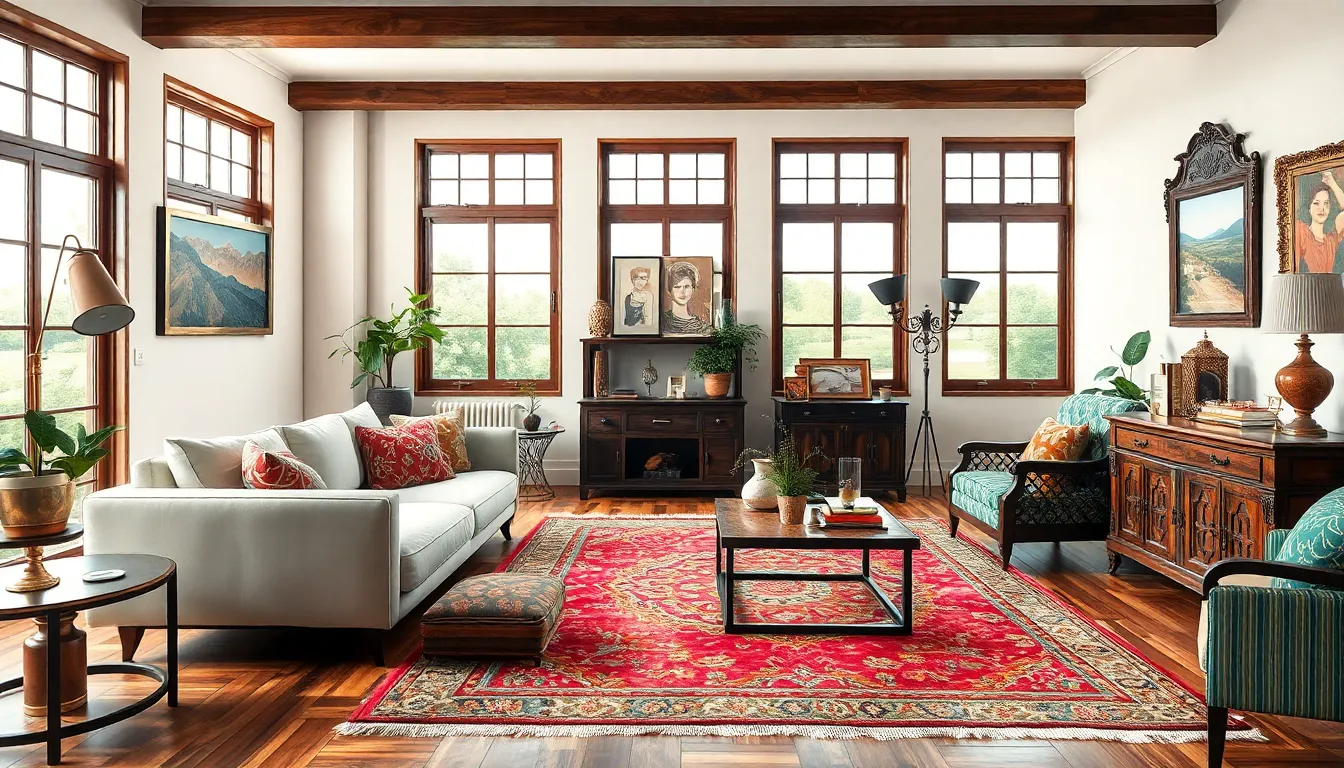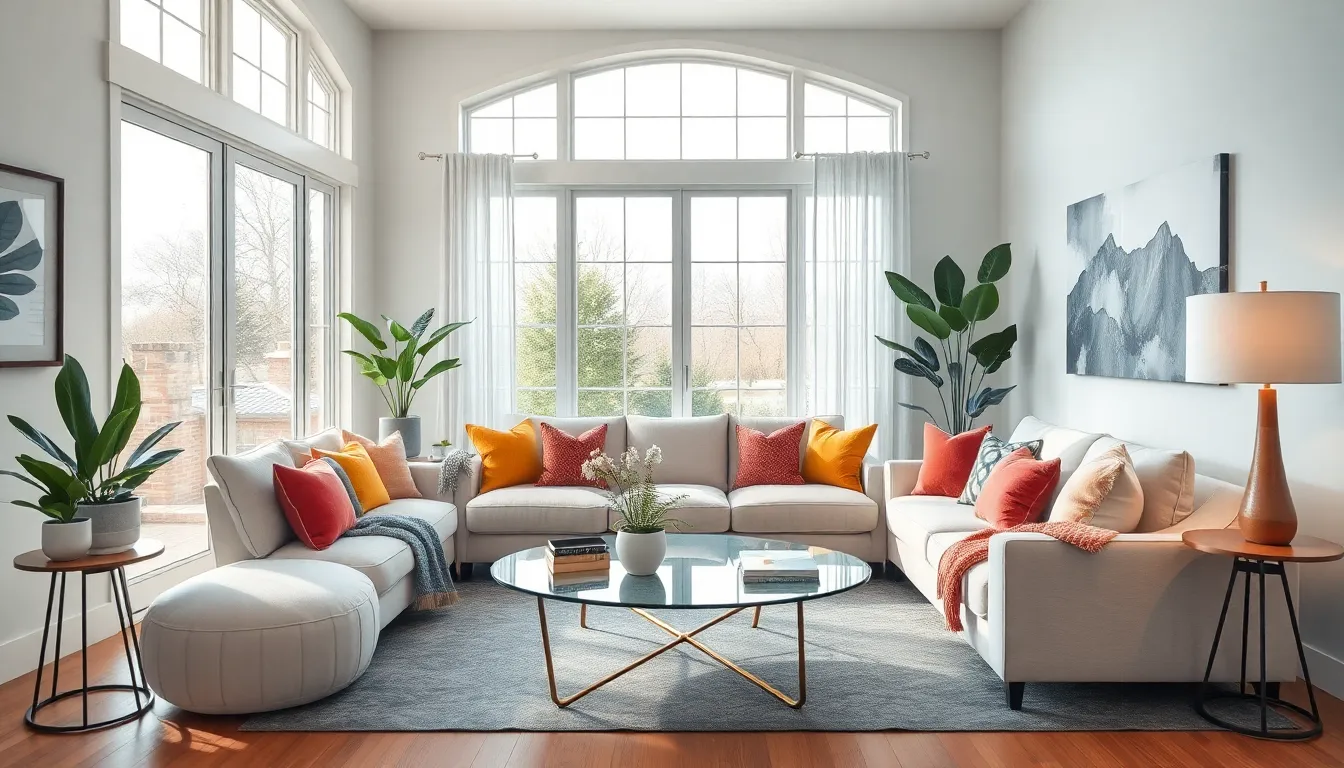Transforming a space isn’t just about slapping some paint on the walls and calling it a day. It’s an art form that can turn a drab room into a vibrant sanctuary or a cluttered mess into a chic masterpiece. Interior design concepts are the secret sauce that makes this magic happen. From minimalist vibes to bold bohemian styles, there’s a concept for every taste—and every budget.
Imagine walking into your home and feeling like you’ve just stepped into a magazine spread. With the right design concepts, that dream can become a reality. Whether you’re a design novice or a seasoned pro, understanding these concepts can elevate your space and impress your guests. So grab your favorite beverage and let’s dive into the world of interior design, where creativity knows no bounds and every room has a story to tell.
Interior Design Concepts
Interior design encompasses a wide range of ideas that influence how spaces are shaped. Learning about these concepts allows individuals to create environments that resonate with their personal style.
Historical Background
Interior design concepts evolved significantly over centuries. Ancient civilizations valued functionality and aesthetics, with examples seen in Egyptian tombs and Roman villas. The Renaissance period introduced symmetry, proportion, and harmony, marking a shift towards more elaborate aesthetics. The Industrial Revolution brought new materials and technologies, allowing for innovative designs. Mid-century modern design emphasized simplicity and organic forms. Today’s design trends reflect a blend of historical influences, merging old-world charm with contemporary techniques.
Key Principles of Design
Interior design works on several key principles that guide effective space planning. Balance creates a sense of equality among visual elements, achieved through symmetrical or asymmetrical arrangements. Focal points draw attention to a specific area, often using art or furniture as the centerpiece. Scale determines the size relationships between objects, ensuring harmony in space. Color influences mood and atmosphere, with palettes carefully chosen to enhance a room’s character. Lastly, texture adds depth and interest, combining various materials for a richer experience. Understanding these principles greatly improves design outcomes.
Popular Interior Design Styles

Interior design styles offer various ways to enhance spaces, each with its own distinct characteristics and appeal. Exploring these styles allows for personal expression in any environment.
Modern Design
Modern design emphasizes simplicity and functionality. Clean lines, open spaces, and minimal clutter define this style. Neutral colors dominate, often accented with bold hues or materials. Furniture tends to feature sleek silhouettes and geometric shapes. Key elements include the use of natural light and incorporation of innovative materials, such as glass and metal. This approach creates a cohesive look that feels fresh and inviting.
Traditional Design
Traditional design draws inspiration from history, showcasing classic features. Rich color palettes, ornate furniture, and intricate details highlight this style. Warm woods and luxurious fabrics offer a sense of elegance and comfort. Accessories often include heirlooms, artwork, and decorative items that tell a story. Symmetrical arrangements are common, contributing to a balanced aesthetic. This timeless design invites familiarity and warmth into the home.
Eclectic Design
Eclectic design embraces a mix of styles, allowing for individual creativity. Diverse patterns, colors, and textures blend harmoniously in this approach. Unique items from various eras create visual interest and personal narrative. Accessories play a significant role, showcasing an array of cultural influences. Mixing modern and vintage pieces can bring unexpected charm to spaces. This flexible style encourages self-expression and a distinctive atmosphere.
Elements of Interior Design
Interior design incorporates key elements that shape the aesthetic and functionality of a space. Understanding these elements helps create environments that reflect personal style.
Color Theory
Color theory plays a crucial role in interior design. It influences mood and perception within a room. For instance, warm colors like red and orange energize spaces, while cool colors such as blue and green promote calmness. Designers often use color palettes to create harmony and contrast. Choosing complementary colors enhances visual appeal. Understanding the color wheel aids in selecting shades that work well together. Applying these principles allows for dynamic and inviting interiors.
Space Planning
Space planning is essential for effective interior design. It involves arranging furniture and decor to maximize usability and flow. Effective layouts consider traffic patterns, functionality, and aesthetic balance. Designers utilize measurements to ensure appropriate scale and proportion. Creating defined areas for specific activities enhances the overall experience. Using software tools can assist in visualizing designs before implementation. Adequate space planning transforms a cluttered room into an organized haven.
Furniture Selection
Furniture selection significantly impacts interior design. Choosing pieces that align with the overall style contributes to coherence. Quality materials and craftsmanship enhance durability and aesthetics. Prioritizing comfort ensures that spaces are functional and inviting. Mixing different styles creates visual interest while maintaining balance. Selecting versatile items allows for adaptability in design. Thoughtful furniture choices elevate the overall ambiance of any room.
The Role of Texture and Lighting
Texture and lighting play crucial roles in interior design, influencing the feel and aesthetics of spaces. Both elements contribute to creating an inviting atmosphere.
Importance of Texture
Texture adds depth and interest to a room. It provides visual contrast, making surfaces more engaging. Soft textiles like velvet or cotton offer warmth and comfort. On the contrary, materials such as metal or glass bring modern refinement. Various textile choices enhance acoustic properties, reducing noise levels within a space. High and low textures can coexist, enriching the overall design. Combining smooth and rough surfaces creates a dynamic ambiance. Thus, introducing diverse textures can elevate any interior space significantly.
Types of Lighting
Lighting types include ambient, task, and accent, each serving a specific purpose. Ambient lighting acts as the main source of illumination, setting the overall mood. Task lighting focuses on areas where specific activities occur, such as reading or cooking. Accent lighting highlights unique features, such as artwork or architectural details. Layering these lighting types enhances the functionality and aesthetics of a room. Natural light from windows complements artificial sources, creating a balanced environment. Using dimmers allows for flexibility, adjusting brightness to suit different occasions. Mastering these lighting elements transforms spaces and elevates their appeal.
Sustainable Interior Design Concepts
Sustainable interior design focuses on eco-conscious choices that respect the environment and enhance living spaces. These concepts merge style with responsibility, creating harmonious interiors.
Eco-Friendly Materials
Eco-friendly materials play a vital role in sustainable design. Bamboo, reclaimed wood, and recycled glass offer environmentally friendly options that reduce waste. Natural fibers such as organic cotton and hemp are ideal for textiles, promoting healthier indoor air quality. Additionally, low VOC paints prevent harmful emissions, ensuring safer environments. Designers often prioritize sustainably sourced materials that contribute to both aesthetics and environmental health.
Energy Efficiency Practices
Energy efficiency practices significantly impact sustainable interiors. Installing LED lighting reduces electricity consumption while providing ample illumination. Utilizing energy-efficient appliances lowers operational costs and conserves energy. Proper insulation and energy-efficient windows minimize heat loss and improve comfort. Incorporating smart home technologies allows for optimized energy use, enhancing overall sustainability. These practices not only benefit the environment but also create comfortable and appealing spaces.
Conclusion
Embracing interior design concepts opens up a world of possibilities for transforming any space. With a solid understanding of key principles and styles, individuals can craft environments that resonate with their unique tastes. The blend of functionality and aesthetics plays a pivotal role in creating inviting atmospheres that enhance daily living.
As trends evolve and sustainability becomes a priority, integrating eco-friendly practices into design choices can elevate spaces while promoting environmental responsibility. By exploring various design elements and styles, anyone can create a home that tells their story and reflects their personality. Whether through color, texture, or innovative layouts, the journey of interior design is both rewarding and inspiring.

